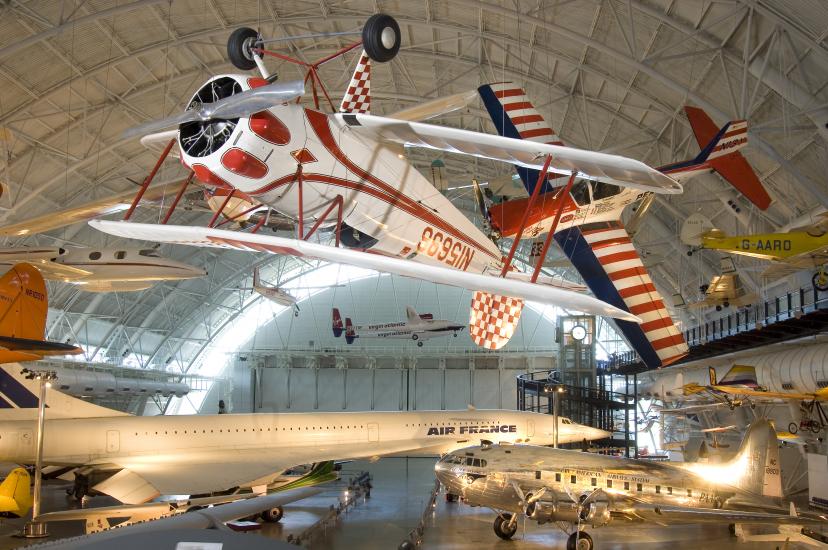Recently, my husband and two of our sons had the incredible experience of a personalized tour of the Smithsonian National Air and Space Museum in Chantilly, Virginia (not the sister location on the Smithsonian’s Washington Mall). Our gracious host was Paul Lockhart, an astronaut who was the pilot and then commander of two NASA Space Shuttle flights on Endeavour in 2002.
The connection we have to Paul is through my husband’s former college classmate. At meeting him at a recent reunion, my husband (a fanatic about anything “space’) not so subtly asked him if he’d be willing to show us around the enormous museum since he lives nearby the museum, and obviously knows a thing or two about aviation.
The Air & Space Museum is an ENORMOUS facility housing an overwhelming array of everything from early airplanes (think Wright Brothers) to the Enola Gay, to fighter jets, missiles, stealthy reconnaissance aircraft and – the biggest attraction, the actual shuttle Discovery, which takes up an entire airplane hangar, impressively tall and wide to accommodate its enormity.
Paul Lockhart was not only the pilot of two space shuttle missions, but also is an aerospace engineer, a highly decorated retired Air Force Colonel, former test and fighter pilot with several combat tours in his repertoire. So how does a fighter pilot get to become an astronaut?
As he put it, he was “on loan” to NASA from the Air Force, recruited because of his piloting skills. The training for the shuttle took just over a year.
Amazingly, he remained humble and modest as he guided us like a docent through a four hour tour. My mind was flying (pun intended) with information overload. He casually walked us through aviation history displays with more detail than most of us could digest.
Even the real docents of the museum on hand that day who are highly trained to answer questions were intrigued by his knowledge as they overheard our unofficial tour. Yet he did not offer his identity or accomplishments to docent after docent, even when they asked.
Our sons, grown into adults now resembled awestruck elementary students on a field trip, soaking in all of our new astronaut friend’s knowledge. In fact, I was taken aback by their own questions and knowledge of specific aircraft and warfare history.
Paul casually pointed out some of the planes he has piloted, including the F-4 and F-16, and casually pointed out the missiles on display that he was responsible for dropping on certain targets.

He should have been cast in Top Gun. (In fact, one of his fellow fighter pilots was actually flying aircraft in several scenes, complaining that Tom Cruise’s custom helmet was far too small, adding difficulty as his “body double” role.)
The museum’s finale was the space shuttle Discovery. Though not the one he piloted and commanded, the Discovery is exactly the same as Endeavor, and he was able to describe every inch of this inexplicitly massive spacecraft, why it was designed thus, and the physics of takeoff, flight, orbit, docking to the International Space Station, etc.
A stander-by started eavesdropping on his discussion with us, so suddenly Paul had another captivated listener. And like the Pied Piper, people started gravitating towards, and suddenly our private tour was no longer private (he later said he’s used to it). One in the group asked him incredulously whether he flew the Discovery. “No,” he said with a poker face.
Relentlessly, the man kept trying to figure him out. “What’s your name?” “Paul,” he modestly replied.
My husband quietly told him Paul Lockhart, which prompted the man to look it up on his iPad, and before we knew it, a small crowd was requesting photos with him. He patiently obliged.
Not only were we treated to this special tour, but then were invited back to the house, where his wife Mary spoiled us with a lovely dinner. (Mary is another story altogether. Also an Air Force retiree, she now runs a company that manufactures specialized drones.)
Although no one really likes to sit through family movies, we and the kids sat on their sofa captivated by their home movies that include real footage of what it was like living and piloting a space shuttle for approximately 14 days in space, responsible for safely dropping off and picking up scientists from the International Space Station. And then returning safely into earth’s atmosphere. The footage we were shown is fascinating.
Unfortunately, Paul lost two close friends in the Columbia shuttle disaster, but the space and astronaut community is exceptionally close like a real family. They take care of each other. “It’s all part of the commitment,” said Mary, mother of two daughters. She remains good friends with the widows to this day.
Fortunately, Endeavour’s missions in 2002 were pretty much seamless except for a few delays while in orbit. That’s when the funny home movies took place: astronauts playing with water that defies gravity, practical jokes on each other to kill time, and plenty of photographic opportunities to see earth from the darkness of outer space.
I highly recommend a day or overnight trip to see the Smithsonian’s Air & Space museum in Chantilly, Virginia. Plan on spending a few hours there, soaking in the realization that in a mere 60 years, we went from a 180-foot flight by the Wrights to space travel. What’s next?


